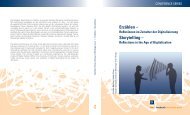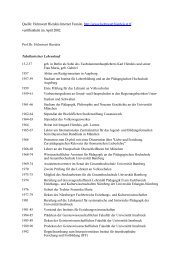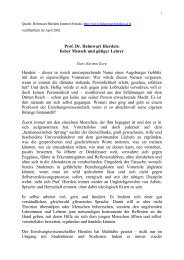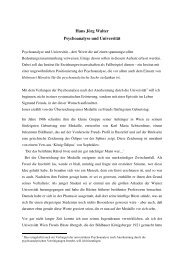Download pdf - Universität Innsbruck
Download pdf - Universität Innsbruck
Download pdf - Universität Innsbruck
Sie wollen auch ein ePaper? Erhöhen Sie die Reichweite Ihrer Titel.
YUMPU macht aus Druck-PDFs automatisch weboptimierte ePaper, die Google liebt.
54 Nicholas A. John<br />
First, given the interrelations between the three spheres of sharing discussed above, it<br />
would appear that a full understanding of one sphere of sharing requires an appreciation of<br />
the others as well. For instance, the deployment of a rhetoric of sharing by Facebook<br />
draws on the meanings of sharing in the therapeutic narrative. Or: the technological affordances<br />
of Web 2.0 enable new types of sharing economies of both production and consumption.<br />
These interrelations might be at least partly explained in terms of Lakoff and<br />
Johnson’s observation that “metaphorical concepts are ways of partially structuring one<br />
experience in terms of another” (Lakoff & Johnson, 1980 p. 77), though if the proponents<br />
of Collaborative Consumption are to be believed, then merely by participating in Web 2.0<br />
we are likely to become more positively disposed to sharing concrete things.<br />
Second, the above mentioned contemporary practices of sharing—in Web 2.0, in sharing<br />
economies, and in intimate relationships—all quite clearly involve shifting boundaries<br />
between the public and the private. In Web 2.0 this is easily seen in both academic research<br />
into the implications of SNS use for privacy, as well as in the intense public discourse<br />
in this regard. The example of couchsurfing as a practice that blurs public/private<br />
boundaries has already been mentioned, to which we might add the visual play on words<br />
on the front cover of What’s Mine is Yours (Botsman & Rogers, 2010): the letter Y at the<br />
beginning of “Yours” is written in a different color from the rest of the word, thus deliberately<br />
collapsing “yours” (the private) into “ours” (the public).<br />
Third, and most tentatively, perhaps we should start to see sharing as central to the structure<br />
of personhood among so-called Generation Y, or Millennials (see Strauss & Howe,<br />
2000). In interviews to promote her new book, Alone Together (Turkle, 2011), Sherry<br />
Turkle has described today’s young people as adhering to a creed of “I share, therefore I<br />
am” (see New York Times 2011 for example; and see Turkle, 2011, esp. Chapter 9). In<br />
particular, she is critical of how young people cannot experience anything without Tweeting<br />
about it or writing about it on Facebook. However, perhaps we can take these words of<br />
Turkle’s and see them as describing—neutrally, non-judgmentally—how a certain type of<br />
self orientates itself in the world: it conducts its social life by sharing on online platforms;<br />
it conducts its commercial life through various sharing economies; and it conducts its intimate<br />
life by sharing emotions and feelings with significant others. This emic view makes<br />
no normative claim as to the value or worth of sharing in each of these spheres. What this<br />
paper does claim, however, is that if our phenomenological experience of everyday life is<br />
mediated by the categories that are expressed through language, then the rise and rise of<br />
the notion of sharing deserves our very close attention.
















